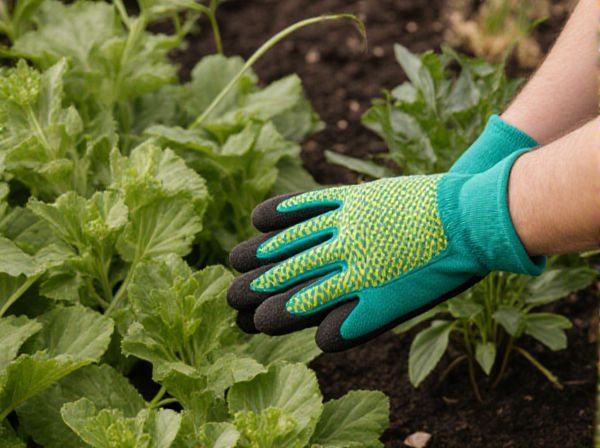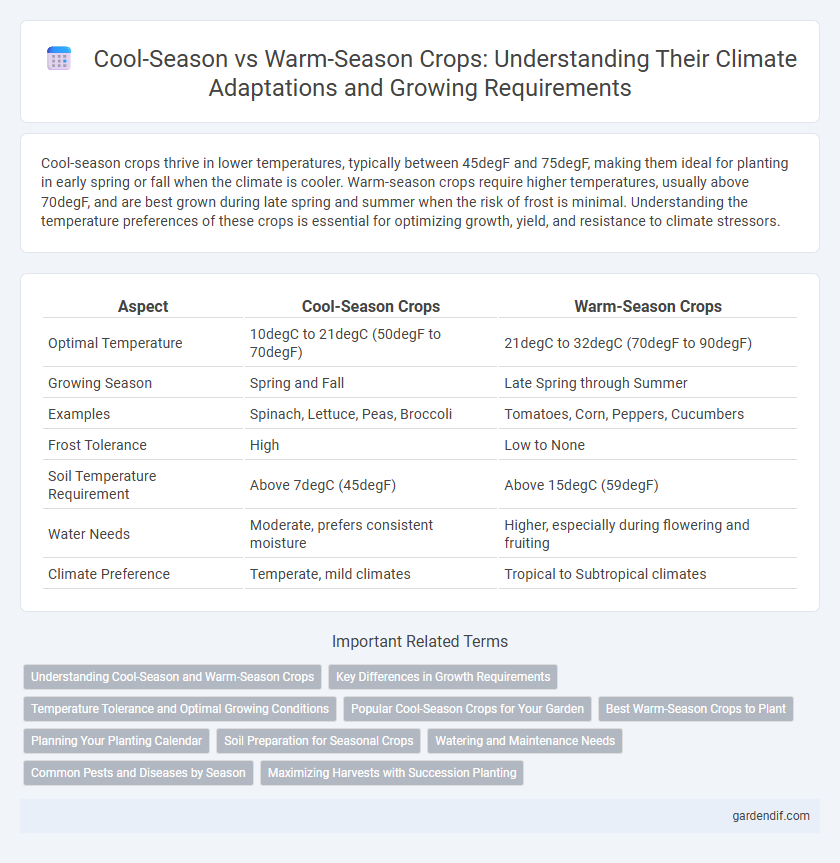
Cool-season crops vs Warm-season crops Illustration
Cool-season crops thrive in lower temperatures, typically between 45degF and 75degF, making them ideal for planting in early spring or fall when the climate is cooler. Warm-season crops require higher temperatures, usually above 70degF, and are best grown during late spring and summer when the risk of frost is minimal. Understanding the temperature preferences of these crops is essential for optimizing growth, yield, and resistance to climate stressors.
Table of Comparison
| Aspect | Cool-Season Crops | Warm-Season Crops |
|---|---|---|
| Optimal Temperature | 10degC to 21degC (50degF to 70degF) | 21degC to 32degC (70degF to 90degF) |
| Growing Season | Spring and Fall | Late Spring through Summer |
| Examples | Spinach, Lettuce, Peas, Broccoli | Tomatoes, Corn, Peppers, Cucumbers |
| Frost Tolerance | High | Low to None |
| Soil Temperature Requirement | Above 7degC (45degF) | Above 15degC (59degF) |
| Water Needs | Moderate, prefers consistent moisture | Higher, especially during flowering and fruiting |
| Climate Preference | Temperate, mild climates | Tropical to Subtropical climates |
Understanding Cool-Season and Warm-Season Crops
Cool-season crops such as lettuce, spinach, and peas thrive in temperatures between 45degF and 75degF, showing high tolerance to frost and cooler soil conditions. Warm-season crops like tomatoes, peppers, and corn require temperatures above 60degF for optimal growth and are sensitive to frost, needing a longer growing season with consistent warmth. Understanding the temperature ranges and growth cycles of cool-season and warm-season crops is essential for maximizing agricultural yield and managing planting schedules effectively in different climates.
Key Differences in Growth Requirements
Cool-season crops such as lettuce, broccoli, and spinach thrive in temperatures ranging from 55degF to 75degF, requiring moderate sunlight and well-drained soil with consistent moisture. Warm-season crops like tomatoes, peppers, and corn demand higher temperatures between 70degF and 95degF, abundant sunlight, and prefer soil that warms quickly with less frequent watering. Understanding these distinct temperature tolerances and soil moisture needs is crucial for optimizing crop yields and ensuring successful planting schedules.
Temperature Tolerance and Optimal Growing Conditions
Cool-season crops such as lettuce and spinach thrive in temperatures between 45degF to 75degF, showing tolerance to light frosts and requiring well-drained, moist soil conditions for optimal growth. Warm-season crops like tomatoes and peppers perform best in temperatures ranging from 70degF to 85degF, needing full sun exposure and consistently warm soil above 60degF to prevent stunted development. Understanding the specific temperature tolerance and ideal growing conditions of these crops enhances yield efficiency and reduces stress-related plant diseases.
Popular Cool-Season Crops for Your Garden
Popular cool-season crops such as lettuce, spinach, and broccoli thrive in temperatures between 45degF and 75degF, making them ideal for early spring and fall planting. These crops prefer cooler weather to maintain tender leaves and reduce bolting, which enhances flavor and texture. Growing cool-season vegetables in your garden extends harvest time and provides a steady supply of nutritious greens.
Best Warm-Season Crops to Plant
Tomatoes, peppers, and cucumbers are among the best warm-season crops to plant due to their preference for temperatures between 70degF and 85degF, thriving in full sun and well-drained soil. Beans and sweet potatoes also perform well in warm climates, benefiting from long growing seasons and consistent moisture. These crops optimize yields when planted after the last frost date in regions with a stable warm-season climate.
Planning Your Planting Calendar
Cool-season crops such as lettuce, spinach, and broccoli thrive in temperatures between 45degF and 75degF, making early spring and late fall ideal planting periods. Warm-season crops including tomatoes, peppers, and corn require soil temperatures above 60degF for optimal germination, typically planted after the last frost date. Aligning your planting calendar with these temperature preferences ensures robust growth and maximizes crop yield throughout the growing seasons.
Soil Preparation for Seasonal Crops
Soil preparation for cool-season crops involves incorporating organic matter and ensuring proper drainage to withstand lower temperatures and moisture retention. Warm-season crops require soil with higher warmth and nutrient availability, often necessitating deeper tillage and the addition of fertilizers to support rapid growth. Proper pH adjustment between 6.0 and 7.0 optimizes nutrient uptake for both crop types, enhancing yield in respective growth seasons.
Watering and Maintenance Needs
Cool-season crops like lettuce, spinach, and broccoli require consistent moisture and benefit from regular, moderate watering to maintain soil hydration without waterlogging. Warm-season crops such as tomatoes, peppers, and cucumbers demand higher water intake, especially during flowering and fruiting stages, and benefit from deep watering to promote root growth. Maintenance for cool-season crops includes mulching to regulate soil temperature and reduce evaporation, while warm-season crops often require staking and pruning to support growth and airflow.
Common Pests and Diseases by Season
Cool-season crops such as lettuce, broccoli, and spinach commonly face pests like aphids and diseases like powdery mildew during damp spring and fall conditions. Warm-season crops including tomatoes, peppers, and corn frequently encounter pests such as armyworms and diseases like bacterial spot in hot, humid summer environments. Understanding the seasonal patterns of pest and disease prevalence aids in implementing targeted integrated pest management strategies for crop protection.
Maximizing Harvests with Succession Planting
Cool-season crops such as lettuce, spinach, and broccoli thrive in temperatures between 45degF and 75degF, allowing for early spring and fall harvests. Warm-season crops like tomatoes, peppers, and cucumbers require temperatures above 60degF to develop fully and are best planted after the last frost. Succession planting exploits the different temperature preferences of these crops, ensuring continuous yields by staggering sowing times and maximizing use of the growing season.
Cool-season crops vs Warm-season crops Infographic

 gardendif.com
gardendif.com